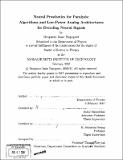Neural prosthetics for paralysis : algorithms and low-power analog architectures for decoding neural signals
Author(s)
Rapoport, Benjamin Isaac
DownloadFull printable version (6.812Mb)
Other Contributors
Massachusetts Institute of Technology. Dept. of Physics.
Advisor
Rahul Sarpeshkar.
Terms of use
Metadata
Show full item recordAbstract
This thesis develops a system for adaptively and automatically learning to interpret patterns of electrical activity in neuronal populations in a real-time, on-line fashion. The system is primarily intended to enable the long-term implantation of low-power, microchip-based recording and decoding hardware in the brains of human patients in order to treat neurologic disorders. The decoding system developed in the present work interprets neural signals from the parietal cortex encoding arm movement intention, suggesting that the system could function as the decoder in a neural prosthetic limb, potentially enabling a paralyzed person to control an artificial limb just as the natural one was controlled, through thought alone. The same decoder is also used to interpret the activity of a population of thalami neurons encoding head orientation in absolute space. The success of the decoder in that context motivates the development of a model of generalized place cells to explain how networks of neurons adapt the configurations of their receptive fields in response to new stimuli, learn to encode the structure of new parameter spaces, and ultimately retrace trajectories through such spaces in the absence of the original stimuli. (cont.) Qualitative results of this model are shown to agree with experimental observations. This combination of results suggests that the neural signal decoder is applicable to a broad scope of neural systems, and that a microchip-based implementation of the decoder based on the designs presented in this thesis could function as a useful investigational tool for experimental neuroscience and potentially as an implantable interpreter of simple thoughts and dreams.
Description
Thesis (S.M.)--Massachusetts Institute of Technology, Dept. of Physics, 2007. Includes bibliographical references (leaves 119-122).
Date issued
2007Department
Massachusetts Institute of Technology. Department of PhysicsPublisher
Massachusetts Institute of Technology
Keywords
Physics.